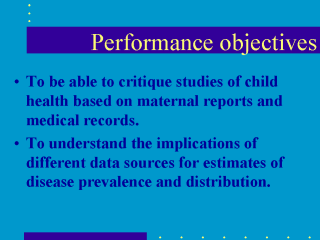 |
With an
understanding of the strengths and weaknesses of the different data sources, one can learn
to critique studies of child health that use one or the other source. Knowing the
potential biases that affect each source can help assess estimates of disease prevalence
and distribution from published studies as well as design and interpretation of data in
one’s own research. Some of the concepts learned in this evaluation of maternal
reports and medical records of children’s chronic health conditions will be applicable
to other age groups and health conditions. For example, recall bias in retrospectively
collected data can affect studies of adult health. Selective under-representation of
certain health conditions and some sociodemographic groups in medical records can also
apply to other age groups and health conditions. |
